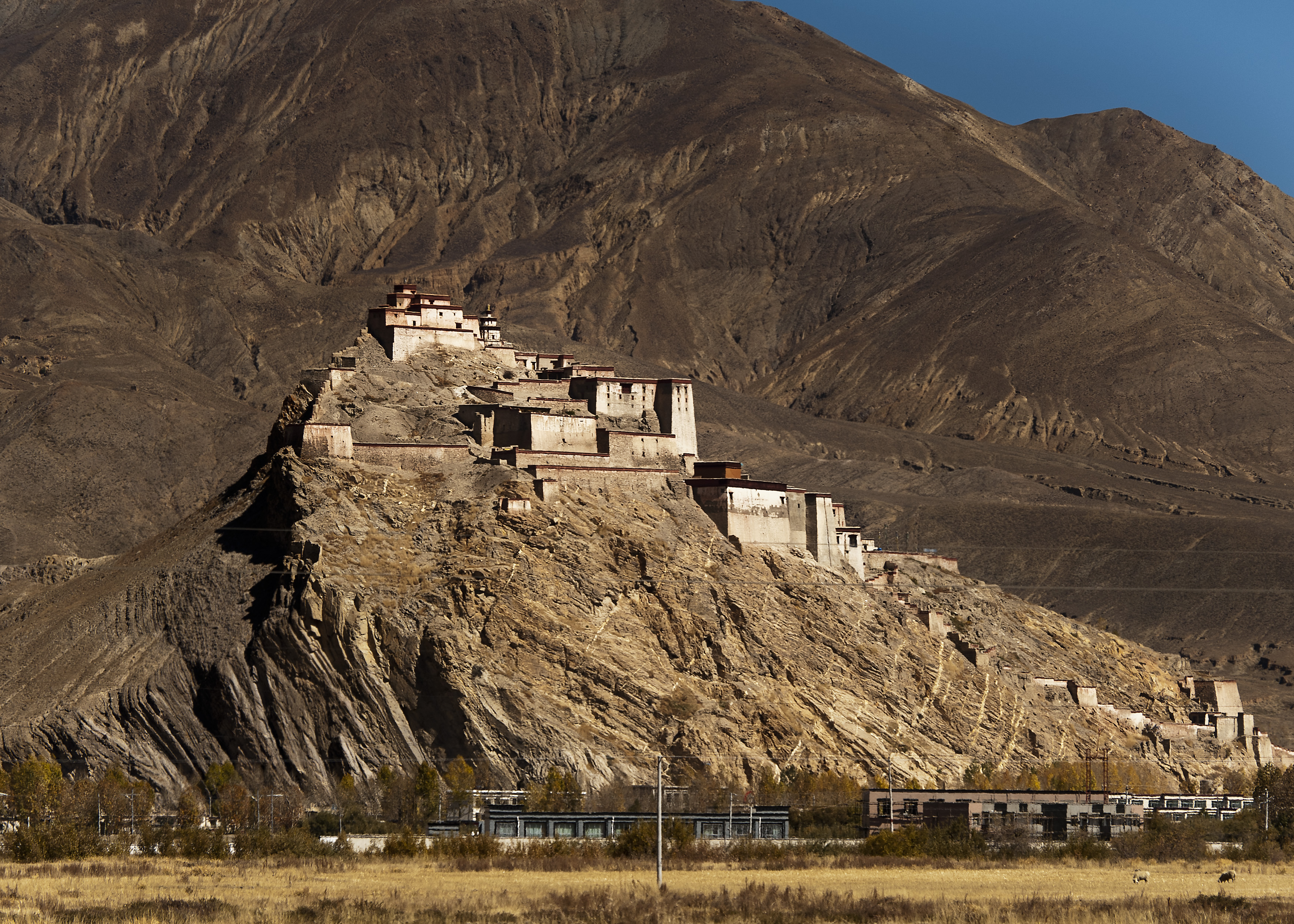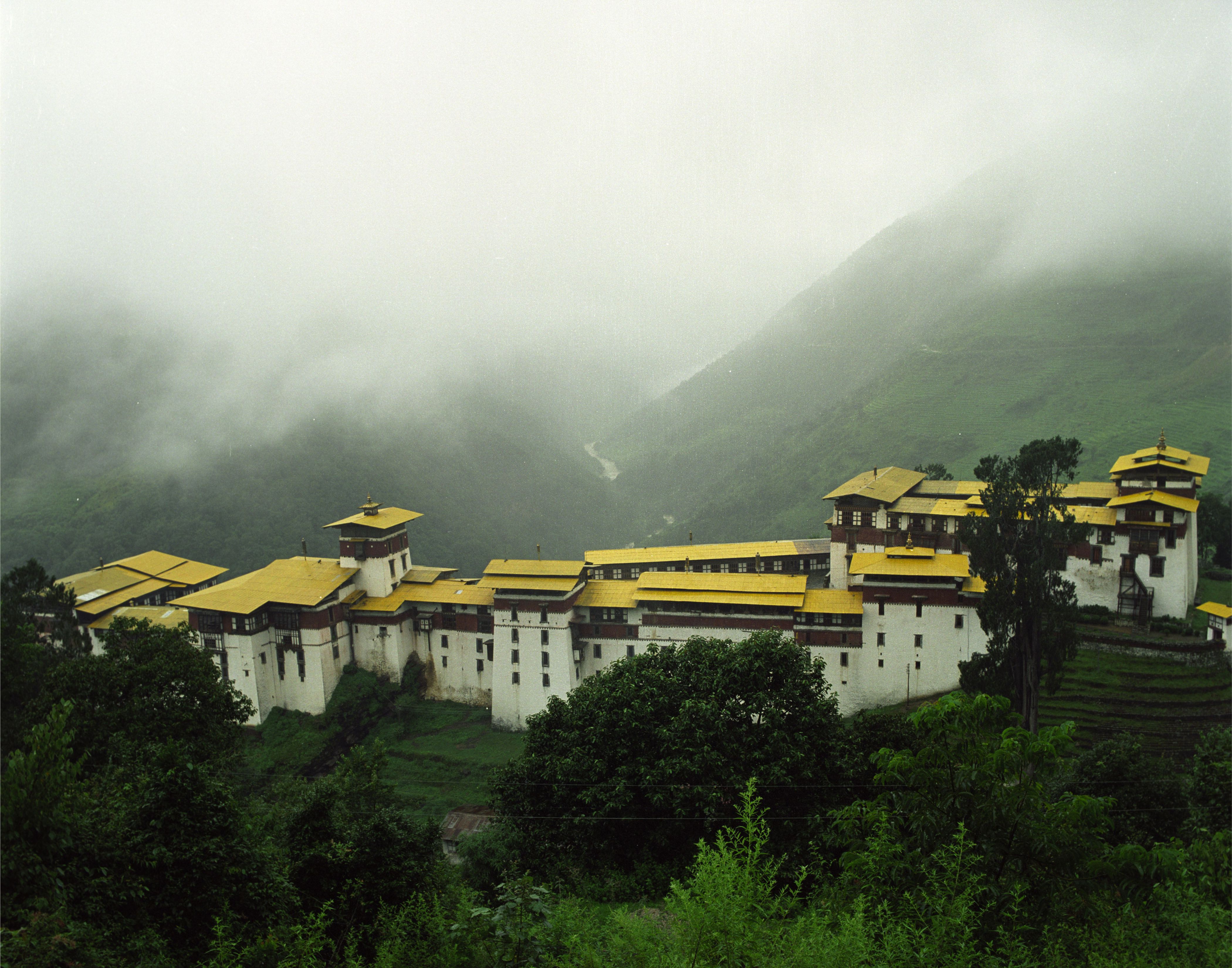|
Dzong
Dzong architecture is used for dzongs, a distinctive type of fortified monastery ( dz, རྫོང, , ) architecture found mainly in Bhutan and Tibet. The architecture is massive in style with towering exterior walls surrounding a complex of courtyards, temples, administrative offices, and monks' accommodation. Characteristics Distinctive features include: * High inward sloping walls of brick and stone painted white with few or no windows in the lower sections of the wall * Use of a surrounding red ochre stripe near the top of the walls, sometimes punctuated by large gold circles * Use of unique style flared roofs atop interior temples * Massive entry doors made of wood and iron * Interior courtyards and temples brightly colored in Buddhist-themed art motifs such as the ashtamangala or swastika Regional differences Bhutan Dzongs serve as the religious, military, administrative, and social centers of their district. They are often the site of an annual ''tsechu'' or religious ... [...More Info...] [...Related Items...] OR: [Wikipedia] [Google] [Baidu] |
Punakha Dzong
The Punakha Dzong, also known as Pungthang Dewa chhenbi Phodrang (meaning "the palace of great happiness or bliss"), is the administrative centre of Punakha District in Punakha, Bhutan. Constructed by Ngawang Namgyal, 1st Zhabdrung Rinpoche, in 1637–38, it is the second oldest and second-largest dzong in Bhutan and one of its most majestic structures. The dzong houses the sacred relics of the southern Drukpa Lineage of the Kagyu school of Tibetan Buddhism, including the Rangjung Kharsapani and the sacred remains of Ngawang Namgyal and the tertön Pema Lingpa. Punakha Dzong was the administrative center and the seat of the Government of Bhutan until 1955 when the capital was moved to Thimphu. It is listed as a tentative site in Bhutan's Tentative List for UNESCO inclusion. Geography The Dzong is located between the Pho Chhu (Male) and Mo Chhu (Female) river in the Punakha–valley. The source of the Mo chu river is in the northern hills of Lighsi and Laya in Bhutan, and i ... [...More Info...] [...Related Items...] OR: [Wikipedia] [Google] [Baidu] |
Bhutan
Bhutan (; dz, འབྲུག་ཡུལ་, Druk Yul ), officially the Kingdom of Bhutan,), is a landlocked country in South Asia. It is situated in the Eastern Himalayas, between China in the north and India in the south. A mountainous country, Bhutan is known as "Druk Yul," or "Land of the Thunder Dragon". Nepal and Bangladesh are located near Bhutan but do not share a land border. The country has a population of over 727,145 and territory of and ranks 133rd in terms of land area and 160th in population. Bhutan is a Constitutional Democratic Monarchy with King as head of state and Prime Minister as head of government. Mahayana and Vajrayana Buddhism is the state religion and the Je Khenpo is the head of state religion. The subalpine Himalayan mountains in the north rise from the country's lush subtropical plains in the south. In the Bhutanese Himalayas, there are peaks higher than above sea level. Gangkhar Puensum is Bhutan's highest peak and is the highest uncl ... [...More Info...] [...Related Items...] OR: [Wikipedia] [Google] [Baidu] |
Dzongpen
Dzongpen ( Dzongkha: རྗོང་དཔོན་; Wylie: ''rjong-dpon''; also spelled "Dzongpon," "Dzongpön," "Jongpen," "Jongpon," "Jongpön") is a Dzongkha term roughly translated as governor or dzong lord. Bhutanese dzongpens, prior to unification, controlled certain areas of the country, but now hold no administrative office. Rather, dzongpens are now entirely subservient to the House of Wangchuck. Traditionally, Bhutan comprised nine provinces: Trongsa, Paro, Punakha, Wangdue Phodrang, Daga (also Taka, Tarka, or Taga), Bumthang, Thimphu, Kurtoed (also Kurtoi, Kuru-tod), and Kurmaed (or Kurme, Kuru-mad). The Provinces of Kurtoed and Kurmaed were combined into one local administration, leaving the traditional number of governors at eight. While some lords ruled from dzongs (dzongpens), others held the title of penlop ( Dzongkha: དཔོན་སློབ་; Wylie: ''dpon-slob''; also "Ponlop"), a title also translated as "governor," though penlops tended to be m ... [...More Info...] [...Related Items...] OR: [Wikipedia] [Google] [Baidu] |
Penlop
Penlop ( Dzongkha: དཔོན་སློབ་; Wylie: ''dpon-slob''; also spelled Ponlop, Pönlop) is a Dzongkha term roughly translated as governor. Bhutanese penlops, prior to unification, controlled certain districts of the country, but now hold no administrative office. Rather, penlops are now entirely subservient to the House of Wangchuck. Traditionally, Bhutan comprised nine provinces: Trongsa, Paro, Punakha, Wangdue Phodrang, Daga (also Taka, Tarka, or Taga), Bumthang, Thimphu, Kurtoed (also Kurtoi, Kuru-tod), and Kurmaed (or Kurme, Kuru-mad). The Provinces of Kurtoed and Kurmaed were combined into one local administration, leaving the traditional number of governors at eight. While some lords were penlops, others held the title Dzongpen ( Dzongkha: རྗོང་དཔོན་; Wylie: ''rjong-dpon''; also "Jongpen," "Dzongpön"), a title also translated as "governor." Other historical titles, such as "Governor of Haa," were also awarded. Under the dual syste ... [...More Info...] [...Related Items...] OR: [Wikipedia] [Google] [Baidu] |
Wangdue Phodrang
Wangdue Phodrang (, Dzongkha 'Wangdi Phodr'a) is a town and capital (dzongkhag thromde) of Wangdue Phodrang District in central Bhutan. It is located in Thedtsho Gewog. History The town shares its name with the Wangdue Phodrang Dzong built in 1638 that dominates the district. The name is said to have been given by Ngawang Namgyal, the 1st Zhabdrung Rinpoche, who was searching for the best location for a dzong to prevent incursions from the south. At the chosen spot, the Zhabdrung encountered a boy named Wangdi playing beside the river and hence named the dzong "Wangdi's Palace". Fire and reconstruction Wangdi Phodrang Dzong burnt down in the afternoon of 24 June 2012, supposedly because of a faulty electrical water cooker. However, the dzong was being renovated at the time, so most of the historical relics had already been put into storage and were saved from destruction. Shortly after the fire, more than 1000 Japanese sympathizers donated an equivalent of over US$134,500 ... [...More Info...] [...Related Items...] OR: [Wikipedia] [Google] [Baidu] |
Wangdue Phodrang Dzong
Wangdue Phodrang District ( Dzongkha: དབང་འདུས་ཕོ་བྲང་རྫོང་ཁག་; Wylie: ''Dbang-'dus Pho-brang rdzong-khag''; previously spelled "Wangdi Phodrang") is a dzongkhag (district) of central Bhutan. This is also the name of the dzong (built in 1638) which dominates the district, and the name of the small market town outside the gates of the dzong—it is the capital ( dzongkhag thromde) of Wangdue Phodrang District). The name is said to have been given by the Shabdrung Ngawang Namgyal who was searching for the best location for a dzong to prevent incursions from the south. The word "wangdue" means unification of Country, and "Phodrang" means Palace in Dzongkha. Wangdue Phodrang is the largest dzongkhag in Bhutan by area and is bordered by Dagana and Tsirang dzongkhags to the south, Tongsa dzongkhag to the east, Thimphu and Punakha dzongkhag to the west, and Gasa dzongkhag and a small section of border with Tibet to the north. It is ... [...More Info...] [...Related Items...] OR: [Wikipedia] [Google] [Baidu] |
Tibetic Languages
The Tibetic languages form a well-defined group of languages descended from Old Tibetan (7th to 9th centuries).Tournadre, Nicolas. 2014. "The Tibetic languages and their classification." In ''Trans-Himalayan linguistics, historical and descriptive linguistics of the Himalayan area''. Berlin: Mouton de Gruyter. According to Tournadre (2014), there are 50 languages, which split into over 200 dialects or could be group into 8 dialect continua. These languages are spoken in the Tibetan Plateau and in the Himalayas in Gilgit-Baltistan, Aksai Chin, Ladakh, Nepal, Himachal Pradesh, Uttarakhand, and Bhutan. Classical Tibetan is the major literary language, particularly for its use in Buddhist literature. Tibetan languages are spoken by some 6 million people, not all of whom are Tibetans. With the worldwide spread of Tibetan Buddhism, the Tibetan language has spread into the western world and can be found in many Buddhist publications and prayer materials; with some western students lea ... [...More Info...] [...Related Items...] OR: [Wikipedia] [Google] [Baidu] |
Tibet Gyantse
Tibet (; ''Böd''; ) is a region in East Asia, covering much of the Tibetan Plateau and spanning about . It is the traditional homeland of the Tibetan people. Also resident on the plateau are some other ethnic groups such as Monpa, Tamang, Qiang, Sherpa and Lhoba peoples and now also considerable numbers of Han Chinese and Hui people, Hui settlers. Since Annexation of Tibet by the People's Republic of China, 1951, the entire plateau has been under the administration of the People's Republic of China, a major portion in the Tibet Autonomous Region, and other portions in the Qinghai and Sichuan provinces. Tibet is the highest region on Earth, with an average elevation of . Located in the Himalayas, the highest elevation in Tibet is Mount Everest, Earth's highest mountain, rising 8,848.86 m (29,032 ft) above sea level. The Tibetan Empire emerged in the 7th century. At its height in the 9th century, the Tibetan Empire extended far beyond the Tibetan Plateau, from C ... [...More Info...] [...Related Items...] OR: [Wikipedia] [Google] [Baidu] |





